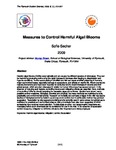Measures to Control Harmful Algal Blooms
| dc.contributor.author | Secher, S. | |
| dc.date.accessioned | 2019-05-13T10:50:37Z | |
| dc.date.available | 2019-05-13T10:50:37Z | |
| dc.date.issued | 2009 | |
| dc.identifier.citation |
Secher, S. (2009) 'Measures to Control Harmful Algal Blooms', The Plymouth Student Scientist, p. 212-227. | en_US |
| dc.identifier.issn | 1754-2383 | |
| dc.identifier.uri | http://hdl.handle.net/10026.1/13864 | |
| dc.description.abstract |
Harmful algal blooms (HABs) occur globally and are caused by different species of microalgae. They can be harmful by producing toxins or by the rapid increase in biomass often leading to discoloration and hypoxic conditions. Toxins accumulating in shellfish and fish can cause shellfish poisoning in humans, major economical losses, especially damage to aquaculture, and affects on marine life. Bloom events are natural phenomena and have been reported for centuries but the recent increase in blooms and their global spread, which are often discussed in relation to human influences, has caused concern. In the absence of reducing such factors, controlling blooms and mitigating effects are essential. Here, methods of controlling HABs by directly targeting the causative algae are reviewed. Studies have shown many possible control measures, biological, chemical and physical, but many methods are restricted by cost, practicality and environmental toxicity. Research on mortality and cell lysis of algae in the wild has lead to studies on biological control by bottom-up and top-down control, but no achievable method has yet been suggested. Flocculation by clay appears promising and is currently used in some areas, but global use is restricted for practical and economical reasons. Many chemicals have also been suggested of which surfactants have received recent attention. Toxicity tests on other, non-target marine organisms are necessary before such chemicals can be considered for use in the field. In the absence of successful control measures, mitigation to minimize effects is often important and widely employed. | en_US |
| dc.language.iso | en | en_US |
| dc.publisher | University of Plymouth | |
| dc.rights | Attribution 3.0 United States | * |
| dc.rights.uri | http://creativecommons.org/licenses/by/3.0/us/ | * |
| dc.subject | Harmful algal blooms | en_US |
| dc.subject | algal | en_US |
| dc.subject | blooms | en_US |
| dc.subject | mitigation | en_US |
| dc.subject | control | en_US |
| dc.subject | flocculation | en_US |
| dc.subject | toxicity | en_US |
| dc.subject | poisoning | en_US |
| dc.subject | fish kills | en_US |
| dc.title | Measures to Control Harmful Algal Blooms | en_US |
| dc.type | Article | |
| plymouth.issue | 1 | |
| plymouth.volume | 2 | |
| plymouth.journal | The Plymouth Student Scientist |



